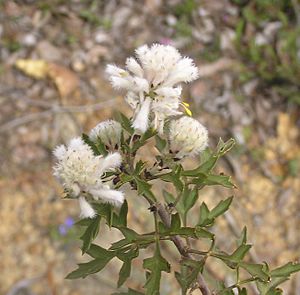Petrophile diversifolia facts for kids
Quick facts for kids Petrophile diversifolia |
|
|---|---|
 |
|
| In Mount Barker | |
| Scientific classification | |
| Genus: |
Petrophile
|
| Species: |
diversifolia
|
| Synonyms | |
|
|
Petrophile diversifolia is a special flowering plant found only in southwestern Western Australia. It's a type of shrub that belongs to the Proteaceae plant family. This plant has interesting leaves that are divided into many parts, making them look a bit like a fern. It also grows oval-shaped flower heads with white or creamy-white flowers that are quite hairy.
What it Looks Like
Petrophile diversifolia is a shrub that usually grows between 0.7 and 3 meters (about 2 to 10 feet) tall. Its young branches are hairy, but they become smooth as they get older.
The young leaves are soft and often have a reddish color. They look a lot like fern leaves. As the plant grows, the adult leaves become smooth. These leaves are divided into many smaller parts, sometimes twice or even three times. They are usually 30 to 110 millimeters (about 1 to 4 inches) long. Each leaf sits on a stalk called a petiole, which is 6 to 26 millimeters (about 0.2 to 1 inch) long. Most leaves have between 35 and 55 sharp, pointed sections.
The flowers grow in oval-shaped heads, which are about 20 millimeters (less than an inch) long. These heads sit on a stalk called a peduncle, which is 10 to 20 millimeters (about 0.4 to 0.8 inches) long. At the bottom of each flower head are egg-shaped leaves called involucral bracts. The individual flowers are 10 to 12 millimeters (about 0.4 to 0.5 inches) long and are covered in hairs. They are usually creamy-white or white.
This plant flowers from September to December. After flowering, it produces small, dry fruits called nuts. These nuts are joined together in an oval or cylinder-shaped head, which can grow up to 30 millimeters (about 1.2 inches) long.
Plant Name and History
The plant Petrophile diversifolia was officially named in 1810. It was named by a famous botanist named Robert Brown. He wrote about it in a scientific paper for the Linnean Society of London.
The second part of its name, diversifolia, is a Latin word. It means "different-leaved." This name was chosen because the plant's leaves can have many different shapes.
Where it Grows
This type of petrophile plant grows in sandy areas. You can find it in scrublands, forests, and other shrubby areas. It grows between the Blackwood River and the Stirling Range. You can also find it near Bremer Bay.
It lives in several different natural areas of southwestern Western Australia. These areas include the Esperance Plains, Jarrah Forest, Swan Coastal Plain, and Warren regions.
How it is Protected
The Western Australian Government's Department of Parks and Wildlife keeps track of plants like Petrophile diversifolia. They have classified this plant as "not threatened." This means that there are enough of these plants in the wild, and they are not currently at risk of disappearing.

